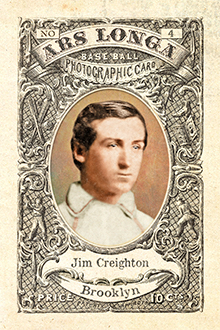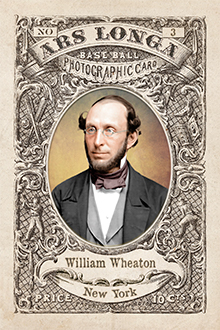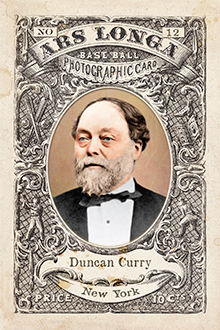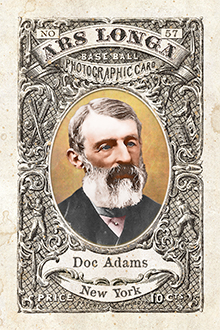What can we make of Jim Creighton?
Among those with an interest in the earliest days of baseball, he is famous both for his exploits on the field, and for the fact that the vast majority of sports fandom is completely unaware of those feats. He was a great hitter, a great fielder and a revolutionary pitcher, and he was the focal point of the 1860 season, the year baseball took the final leap from a diversion for gentlemen’s social clubs to the chief concern of sports fanatics in the East. As a standout in cricket as well, he may have been, for a brief time, the nation’s finest athlete. If he wasn’t the very best baseball player in the nation, he was certainly the first superstar, perhaps the first individual player that could draw a crowd on his own. He may also have been the first professional player.
But for all his accomplishments, there is precious little we can know about Jim Creighton. For most players, a simple recitation of on-the-field performances would suffice, but Creighton made choices in his all-too-brief career that make one yearn to know more. His character remains a blank slate to us, and that’s really no surprise. There was so little time to get to know him. He passed away in a Bunyon-esque manner, at 21 years, six months and three days of age.
To appreciate Creighton’s quick rise from relative anonymity to stardom, one needs to understand the organization of baseball in its earliest days. Games of ball and bat have been around almost as far back as we can document human social history. In the United States, the phrase “base ball” turns up half a century earlier than 1839, when Abner Doubleday didn’t invent baseball at Cooperstown, N.Y. The British game of “rounders” or variations of “cat” had been played for years by children or at rural holiday gatherings.
But it was the 19th Century version of yuppies, the young urban professionals of New York, who developed a game that was something more than a diversion for children. It became the fashion for city workers in the early decades of the century to seek out a healthful form of organized recreation, and if it allowed for socializing with one’s peers, so much the better.
A handful of clubs began to spring up around the idea, with names like Gotham and Eagle. And finally, there were the Knickerbockers, who formed in 1845. The Knickerbockers weren’t necessarily the best players (they lost history’s first recorded game, 23-1, to the New York Ball Club in 1846) but their true genius was in organization. Behind such leaders as William Wheaton, Duncan Curry, Doc Adams and Alexander Cartwright, they took charge of codifying the rules of what was know as the “New York game,” a version of bat-and-ball that eventually won out over other regional variations.
For years, the Knickerbockers’ role as “keepers of the rules” was accepted by other clubs, but as the game grew in the mid-’50s, a larger form of organization was needed. In 1957, sixteen clubs from New York, Brooklyn and Morissania (the present-day Bronx) came together to form the National Association of Base Ball Players. These were social clubs that included many more members than just the nine who represented each club on the field. Some were more erudite, some were more working class, but they had banded together to compete at the highest level.
Of course, the game was bound to be popular with men too young to join a social club, and this led to a growing underclass of youth teams. In that summer of ’57, Jim Creighton was a 16-year-old growing up in Brooklyn, and had shown promise in both baseball and cricket. He and some neighborhood friends started their own team with the grandiose name of Young America. Playing mostly intrasquad games, Young America disbanded by the end of the year, but Creighton’s services were snapped up by the Niagara Club, another local youth team.
Such youth teams competed at a level below those of the senior clubs, but they received a surprising amount of attention from the fledgling sports media. For instance, the July 24, 1858 edition of the New York Clipper had extensive coverage of the first game in the Fashion Course series, an all-star competition pitting the best players from New York clubs against those of Brooklyn clubs, the first major “event” in the sport’s history. In an adjacent column was coverage of the Niagara Club’s 39-31 loss to Sylvan, in which third baseman J. Creighton scored four runs.
But although youth teams were theoretically equal, some were more equal than others. For an aspiring player like Creighton, the Niagara Club trumped Young America. And there was a higher level yet . . .
On July 19, 1859, one of the most significant games in the history of baseball’s development was played. A large crowd was on hand at the grounds of the Olympic Club in South Brooklyn to see the Star Club take on the Niagara Club.
The attraction was the Stars, considered the “crack” junior club of the area. While youth teams had a tendency to come and go, the Star Club had maintained its core group for several seasons, and though still made up of teenagers, it was showing evidence of being able to compete with any club in the area. It had opened the season with victories over Charter Oak, a senior team, and Hamilton of Jersey City. The latter game was played on the same day as a marquee battle between heavyweights Atlantic and Eckford, which kept the Stars’ crowd down, but there was no such competition for the attention of the baseball world when they squared off against the Niagaras. The New York Times reported that “an unusually large audience, numbering representatives from almost every New-York and Brooklyn Club, were gratified spectators of the well-contested game.”
Apparently, everyone wanted to know if the Star Club was for real. What they saw, however, was even more enlightening.
Legend has it that with the Stars well ahead in the fifth inning, Creighton took over on the mound for Niagara’s starter, John Shields. It may not have been Creighton’s first turn as a pitcher in a competitive game, but it was certainly the first time he had been seen by a large audience. One of the players in attendance was Peter O’Brien, a star outfielder for the Atlantics, and he observed that “when Creighton got to work, something new was seen in base ball — a low, swift delivery, the ball rising from the ground past the shoulder to the catcher.”
To understand why this was a revelation, one must consider the rules of the time, and the role of a pitcher. A pitch was to be delivered in an underhand motion with a stiff arm and a stiff wrist. The batter was allowed to call for a low or high pitch, and if it didn’t come within that area, he didn’t have to swing. The pitcher-batter confrontation that defines the modern game had not yet been established. The focus was not on pitching or even hitting, but rather on fielding. In a sense, the pitcher and batter were charged with conspiring to put the ball into play. A pitcher’s role was roughly the same as a plunger on a pinball table.
Creighton was not the first pitcher to throw a speedy pitch, but, given the limitations of the rules, he may have been the first to do so with any degree of control.
According to legend, the Stars were so befuddled by Creighton’s offerings that they countered by putting their wildest pitcher on the mound, counting on the Niagaras inability to catch up. The Star Club left the field with a 14-8 victory, but some of the leading lights in the world of baseball had seen the sport’s future.
Now, why do I say “according to legend?” Unfortunately, none of the details can be verified by contemporary reports. The Clipper‘s story of the game lauds Creighton’s play . . . at second base! It also credits Shields with being “pretty active” as pitcher. But there is no comment in any publication on Creighton’s pitching efforts. The Stars actually led by only 8-4 when Creighton took the mound, and he hardly shut them down from that point.
The main source of what happened that day — and the O’Brien “observation,” which wasn’t strictly a quote — came from a biographical essay that appeared on the back of a carte de visite of Creighton in pitching motion, that was apparently written a decade after the fact. The card, which may have been an early trade card issued by Peck and Snyder Sporting Goods, and was discovered in a photo archive by historians John Thorn and Mark Rucker.
Can it be trusted? Hard to say . . . given the events that followed, the story makes sense, and seems to have been accepted as reasonably accurate. But like many things that pop up in Creighton’s brief moment in the sun, one has to take it with a grain of salt.
Clearly, the Star Club was impressed, and saw the potential that Creighton represented. The Stars’ next game didn’t take place for another six and a half weeks, and during that time Creighton played once more for the Niagaras (a game in which he was listed as the starting pitcher and was summarily thumped, 28-11, by a youth club called Champion). But when the Star Club took the field on Sept. 3 against the vaunted Excelsiors, he was in the lineup, on the mound.
The Star Club came away with a 17-12 victory, a stunning victory over one of baseball’s top clubs. Even more impressive was the Stars’ 7-3 lead after seven innings . . . a team the caliber of the Excelsiors scoring only three runs in seven innings was unheard of. A particularly detailed play-by-play account of the game by the Clipper gave the defense on both sides most of the credit (until the final two innings, when both teams fell apart in the field), but made little mention of Creighton’s pitching. Still, he had clearly made an impression on the Excelsiors, and others were paying attention as well.
The Knickerbockers next challenged the Star Club to a “fly” game. No longer the sole arbiter of the game’s rules, the Knickerbockers still took it upon themselves to champion the elimination of the “bound” out. At the time, a batter could be put out either by having his fly ball caught, or by the fielder catching it on one bounce. In an attempt to create support for eliminating the bound, the Knickerbockers sponsored exhibition games in which an out could only be made on the fly (or by the usual throwing out of a batter before he could get to first base).
Ten days after beating the Excelsiors, the Star Club hosted the Knickerbockers. “The pitching of Creighton . . . rather surprised them,” according to game coverage in Porter’s Spirit of the Times, “his speed and accuracy telling on their batting with considerable effect.” Creighton held the venerable Knicks to three runs in four innings before rain stopped the game. In a replay two weeks later, the Stars won easily, 33-11.
Following two more victories, the Star Club was unbeaten through six games headed for a game with the recognized champions of Brooklyn, and, therefore, the baseball world: the Atlantics. When the teams met at the Star Club’s Penny Bridge grounds on Oct. 8, the New York Sunday Mercury reported that “Creighton’s pitching somewhat worried the Atlantics,” but the game was suspended with the Atlantics leading, 6-5, in the fourth. The Atlantics returned 11 days later and broke open an 11-11 tie after seven innings to hand the Star Club its first defeat, 15-12.
After defeating Charter Oak on Nov. 10, the Stars finished their season 7-1, and with a solid lineup and a pitching prodigy on hand, the opportunity was ripe for the youth club to graduate to the ranks of Brooklyn’s, and therefore baseball’s, finest teams.
But it didn’t come to pass. Soon after the Stars’ final game on Nov. 10, the Excelsiors announced that Creighton and George Flanley were joining their ranks. In just two years, Creighton had risen from a small-time youth team to the pinnacle of baseball in the mid-19th Century.
It was this last step up the ladder that started the rumors. Going from the neighborhood Young America to the better-organized Niagara Club made sense, as did the next jump to the Star Club, the leading youth team of its day. But a move to the Excelsiors led many to the conclusion that Jim Creighton was being paid under the table.

There was, of course, no other way of being paid to play baseball in 1860 than clandestinely; it was an amateur sport. There were other ways of skirting the rules, though: waiver of club dues, the giving of a patronage job, the handing over of a portion of gate receipts. But the rumor about Creighton was always that we was directly paid for playing. The figure of $500 often shows up in biographies of the young pitcher.
There is no evidence to categorically prove that Creighton was a paid professional . . . indeed, the first paid professional. But in hindsight, there’s every reason to believe it was true.
For one thing, if the Excelsiors chose or needed to pay him, they could. No one accused the Star Club of buying Creighton away from the Niagaras, because there was no way for a group of teenagers to come up with that kind of money. But there was plenty of money in the Excelsior Club membership, which in numbers extended well beyond the nine or 10 players on the baseball first team.
There are arguments that can be made for and against Creighton making the move without financial remuneration. In the early days of organized baseball, senior clubs and youth teams often had working arrangements. For the youth team, there might be social benefits as well as the use of a playing field or equipment; for the larger club, a good youth team could be a supplier of new talent. It happened that the Excelciors and Stars had just such an informal arrangement. In fact, one of the reasons that the Star Club had pursued Creighton in the first place was because it had just lost two of its starters to the Excelsiors.
On the other hand, the Star Club wasn’t just any youth team. It had aspirations to officially join the ranks of the senior clubs and did indeed join the NABBP in early 1860. It would have no desire to lose its new star pitcher.
This is likely one of those cases in which the fact that most people believed that Creighton had been paid probably meant that he had. To our 21st Century sensibilities, this is no big deal, and in fact no one went to any pains to try to have Creighton declared ineligible.
But if he did indeed take pay to play, that act was perhaps as significant as those speedballs he’d thrown across the plate that summer afternoon in 1859. It marked the crossing over for baseball, from a social apparatus for the largely well-to-do, to an enterprise that was drawing attention and interest, from fans and those who wanted to wager alike. Competition was sharpening, and the clubs near the top were going to do whatever it took to compete with those who were on top.
One side note to Creighton’s move was his transaction companion, Flanley. They had been teammates on the Niagaras, and moved together to the Star Club, then the Excelsiors. Flanley was a slight fellow — he was 5-foot-6 and weighed less than 150 pounds — with a reputation as a fine fielder and a weak hitter. According to the game account in the Clipper, he did make at least two outstanding plays in the field during the Stars’ victory over the Excelsiors, which might have stirred the latter club’s interest. And he was a regular in the Excelsior lineup through 1867. But it’s hard not to believe that his primary role was as Jim Creighton’s BFF.
Whatever the case, they were both in place as the Excelsiors prepared to set sail on the most heralded baseball season that had ever been seen.

Coming Soon:
Part 2: The invention of the baseball tour, and a championship series to remember.
Sources:
Baseball in the Garden of Eden by John Thorn
Jim Creighton by John Thorn (SABR bio project at sabr.org)
Baseball’s First Inning by William J. Ryczek
Baseball Founders by Craig B. Waff, William J. Ryczek and Peter Morris
The National Association of Baseball Players, 1857-70 by Marshall D. Wright
Hidden Treasure Discovered in NYPL’s Spalding Collection: The Mystery of Baseball’s First Star — Jim Creighton by Peter J. Nash, April 5, 2011 blog post at haulsofshhame.com
Digital editions of the New York Clipper and New York Times





